How to make hoya bloom - creating ideal conditions for a plant
Lovers of climbing house plants start hoyu at home. This is wax ivy, unpretentious in care, but capricious in flowering. He often does not throw out the buds for several years.
This is due to improper care of the plant, since most amateur owners simply do not know how to make hoya bloom.
Problems can be easily solved if you study all the subtleties before planting or purchasing ivy.
How hoya blooms
In nature hoya grows in Australia, India, China and the Pacific Islands. This is an evergreen liana, a tropical plant and rarely found in Europe - in most cases as an indoor decoration.
Vines have glossy saturated green leaves and voluminous umbellate inflorescences of pink, white, burgundy and yellow. Umbrellas are composed of five-petalled, star-like flowers that reach 9-11 cm in diameter. One bud can have 7 to 50 flowers and weigh up to 200 grams. For one flowering, a plant can throw up to 50 buds.
A huge amount of nectar is collected on the hoya petals. This effect makes the flowers look like waxy ones. In bright light, they start to sparkle.
When and with what frequency does hoya bloom
In good conditions, a hoya should discard buds every year and bloom from May to October. With age, flowering becomes more abundant and longer. The flowers give off a pleasant, very strong aroma, which becomes even richer by nightfall.
Each bud blooms for several weeks, and then dries up, but the next one opens up to replace it. There is no need to cut off the faded peduncles, the next year flowers will bloom on them again.
By autumn, the hoya slows down the flowering intensity and goes into a dormant state. But with good care, it can bloom again in the fall. Permanent flowering can be achieved by creating summer conditions in the house, but this will lead to exhaustion.
Liana will not have time to gain strength from flowering to flowering. Each subsequent swelling of the buds will be less intense, the plant is more susceptible to diseases and its condition will greatly worsen.
Why does not it bloom
Often, owners are faced with the problem of lack of flowering at all. You should panic if there are no ripe buds during the year. In the presented question, there are several reasons for the lack of bud formation.
Diseases
Even in an apartment that is well protected from external influences, the hoya can overtake various diseases that will prevent her from throwing out the buds. All forces will be directed towards the fight against disease.
Table 1. What diseases overtake wax ivy
| Name | Description |
| Rot |
This is a fungal disease. It starts with the fact that the shoots become soft and lethargic, they change color and begin to rot. If the fungus did not have time to spread throughout the plant, diseased shoots must be cut off, and the cut sites must be treated with activated carbon. Dig up the soil in a pot and add coal there too. If the fungus has covered the entire plant, it cannot be saved and must be destroyed. To prevent the fungus from appearing, it is required to observe the irrigation regime and prevent waterlogging of the soil. |
| Chlorosis |
Appears when the process of photosynthesis is disturbed. The color of the leaves becomes lighter, yellowness and white spots appear on them. The plant weakens and looks sick.He has a lack of feeding. It is necessary to spray it with Ferovit solution or its analogues. So it will recover faster than if you inject it under the root. |
| Sooty fungus |
It clogs the pores of the plant, preventing it from breathing. The fungus is visible on a dry film that spreads over the leaves. It is necessary to collect the film, wipe the leaves with soapy water and treat with fungicides. |
| Dry spot |
The fungus begins to destroy the foliage from the bottom of the plant, gradually moving higher and higher. It appears due to frequent changes in temperature and humidity. It is necessary to remove the affected leaves and treat the plant with copper-containing preparations. |
| Phylosticosis |
It affects the leaves. First, dark spots appear, gradually they grow and dry out the leaf, it becomes thin and crumbles. It is necessary to replace the soil in the pot, steam it beforehand. Diseased leaves need to be torn off, reduce the humidity in the room and treat the plant with antifungal agents. |
If you take care of ivy correctly, you can avoid various lesions. But both the disease seen on time and the treatment started will help save the plant without much damage to it.
Pests
Hoya, like other indoor plants, has pests. These include:
- Shield. You can notice that this pest has attacked the plant by looking at the brown bumps with a red rim, which have formed on the leaves. You can fight them with folk remedies: wipe the affected leaves with vinegar, and after a couple of hours rinse them with soapy water. Then rinse the soap off with running water and treat the plant with "Aktara" using a sprayer. This procedure needs to be done three times at intervals of a week.
- Whitefly. It is not difficult to notice it - small white insects will fly over the pot with the plant. It is necessary to treat the plant with the preparations "Tanrek" or "Lepidocide", three times with an interval of 10 days.
- Spider mite. The plant is entangled in cobwebs, and the lower leaves are covered with a white bloom. You need to remove the cobweb with cotton wool dipped in alcohol tincture. After that, the plant must be rinsed with water. Then the liana should be wrapped in plastic along with the pot to maintain high humidity, which the tick does not like. If this does not help, spray the flower with Fitoverm solution 4 times throughout the month with equal intervals.
Pests spoil the plant, starting from the soil, so it is imperative to sterilize the pot and take new soil for transplanting.
Care errors
Hoya, which is grown indoors, often blooms after 2-3 years. But sometimes the plant does not bloom or it has a break after several years of normal flowering. The reasons may vary, but they are all indicative of inadequate care.
The main mistakes in plant care that led to a delay in flowering include:
- There are no transfers. Hoya does not need to be transplanted often, but with a young plant it is necessary to do this every 1-2 years, and with an adult - every 4-5 years. Otherwise, the soil is depleted and the plant lacks nutrients. He needs a new substrate.
- Fertilizer deficiency. Wax ivy always needs fertilization, even after it has been transplanted into a nutrient-rich substrate. But you should not add it in excess - it will not benefit the plant. Lack of them will lead to a delay in flowering.
- Poor conditions of detention. This may be non-observance of optimal conditions of maintenance or improper care of the plant. Errors that led to a delay in flowering include: lack of light, excessive moisture or dryness of the soil, dense soil that prevents air access, low air temperature in the room in winter, heat and low humidity in summer, drafts.
- Large pot. The size of the pot depends on the age of the flower. There should not be much room for soil in it, the whole pot should be occupied by the root system.
- Bulb too deep.The pot should not be deep. In this case, the bulb will not be too deep and there will be a small layer of soil above it.
- There is no rest period. In early October and until March, the plant slows down and falls into a dormant state. This is natural and necessary in order to gain strength before the next flowering. Sometimes ivy skips the dormant period and blooms again in the fall. The plant depletes this, there is not enough time for recovery and in the spring it does not throw out the buds. In this case, you need to organize a dormant period for the plant.
It is necessary to properly care for wax ivy so that it blooms regularly, delights the inhabitants of the house with its aroma and beautiful inflorescences.
How to make it bloom
If you find out the reason why the hoya stopped blooming, it is easy to "start" it, and it will throw away the buds again. That for this you need to adhere to the rules.
Correct pot
Hoya feels good in a small pot. Its root system should completely fill the entire space. Therefore, adult plants should be transplanted rarely so that the roots have time to grow throughout the container. The size of the pot for an adult plant is 15-20 cm in diameter. A tight pot is the best option for a hoya.
Optimal conditions
First of all, ivy needs to create favorable conditions for its development.
Table 2. What rules to pay attention to.
| Condition | Description |
| Watering |
Moisten the soil only after it is completely dry. Significantly reduce the number of irrigations and the volume of water in the autumn-winter season. In summer, water more often and spray regularly. If you dry the soil well in the pot in the winter, the ivy will bloom profusely in the spring. |
| Air humidity |
Hoya calmly tolerates dry air, but for better growth and normal flowering, it must be regularly sprayed. During the flowering period, spraying is replaced by wiping the leaves with a damp cloth. Do not let the water get on the flower petals. |
| Temperature |
The comfortable temperature for the plant is + 18-25 degrees in the summer, +15 and slightly higher degrees in the winter. If the temperature of the content is reduced in winter, the hoya will shed its leaves and will recover for a long time. |
| Lighting | In winter, when there is not enough light, the plant should be placed on the south side. She needs light at least 10 hours at any time. In winter, it is necessary to illuminate with a fluorescent lamp. |
Competent care
If the hoya does not bloom at a certain time, you need to revise the rules for caring for the plant and correct them. If there is a lack of lighting, install an additional lamp in the room.
During the rest period in winter, keep in a cool room at a temperature of 14-16 degrees. By autumn, reduce the amount of watering and moisten the soil when it dries up. Transplant the plant into a cramped pot, because only shoots develop in a spacious container.
Stimulating feeding
In order for the hoya to bloom, some growers use stimulating dressings. Stimulants raise the plant's immunity and increase resistance to infections. Plants after such feeding begin to develop actively and bloom earlier and more abundantly.
The most popular among flower growers are stimulants Ripen, Bio Bloom, Cannabiogen Delta Hesi, Super Vit. They not only encourage the flowering process, but also eliminate pests, increase the flowering period and make it abundant.
Life hacks of florists
Experienced growers share their observations that will help a beginner to cope with the problem. In this case, there are two ways to make ivy bloom - this is holding a water bath and drying the soil.
- Water bath
Experienced growers use a water bath to make the plant bloom. This is done like this: put the pot in a container with water at a temperature of 30 degrees so that the entire root system is covered. Soak for 30 minutes, then lower the shoots of the plant into the container for 1 hour.
- Drying the soil
In winter, place the pot in a low humidity room to dry the soil.Control the condition of the plant so that the leaves do not turn black. When the soil is half dry, place the pot on the east window. By the spring, the plant will throw out numerous buds.
How to care for hoya during flowering
During the flowering period, it needs special attention. In the heat, it is necessary to increase the number of watering and irrigation, since the hoya does not tolerate it well.
It is better not to touch the inflorescences, otherwise they will fall. When flowering, ivy spends a lot of energy, so it needs to be fed with fertilizers.
With proper care, hoya can live for a very long time and every year delight households with lush and bright flowers and a delicate aroma. You should adhere to the listed rules and pay attention to the life hacks of experienced florists.
An experienced florist about hoya bloom:



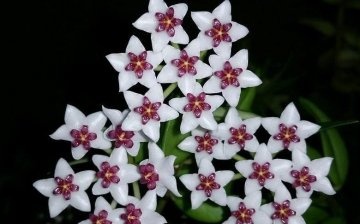
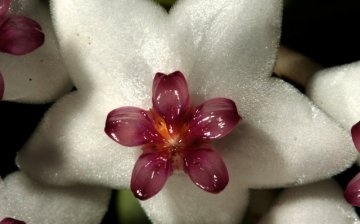
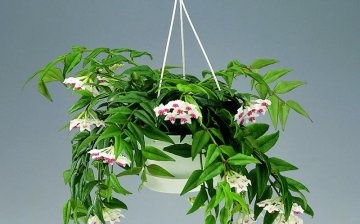
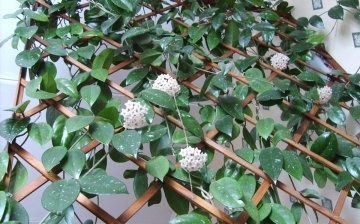




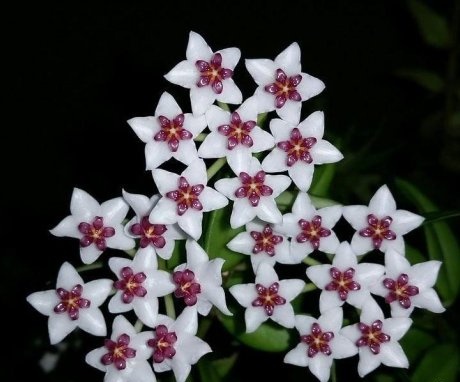
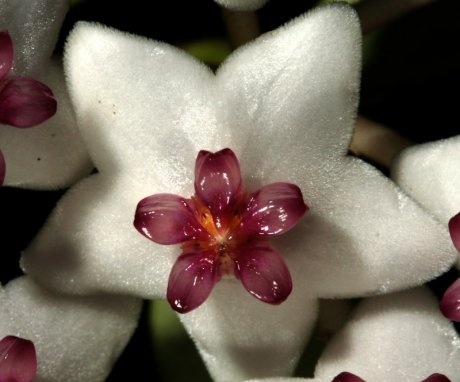
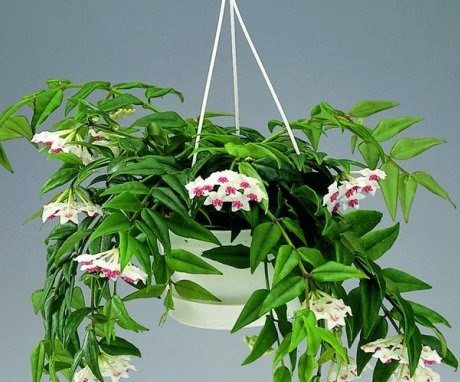
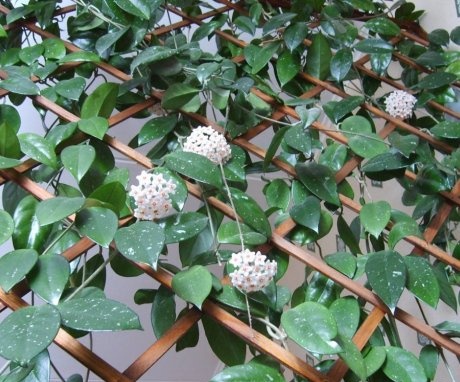
In my opinion, the main reason for the lack of flowering in hoya is improper care of the plant and not creating optimal conditions in the room in terms of air humidity, temperature, illumination and watering.
We bloomed well in a village house. The room was warm, sometimes cool, but the humidity was high enough. Periodically, the soil was sprinkled with ash and fed with standard fertilizers.
I would not dare to try to grow this plant! Moreover, bring it to bloom. It turns out that this plant has so many ailments and diseases, it's already creepy!